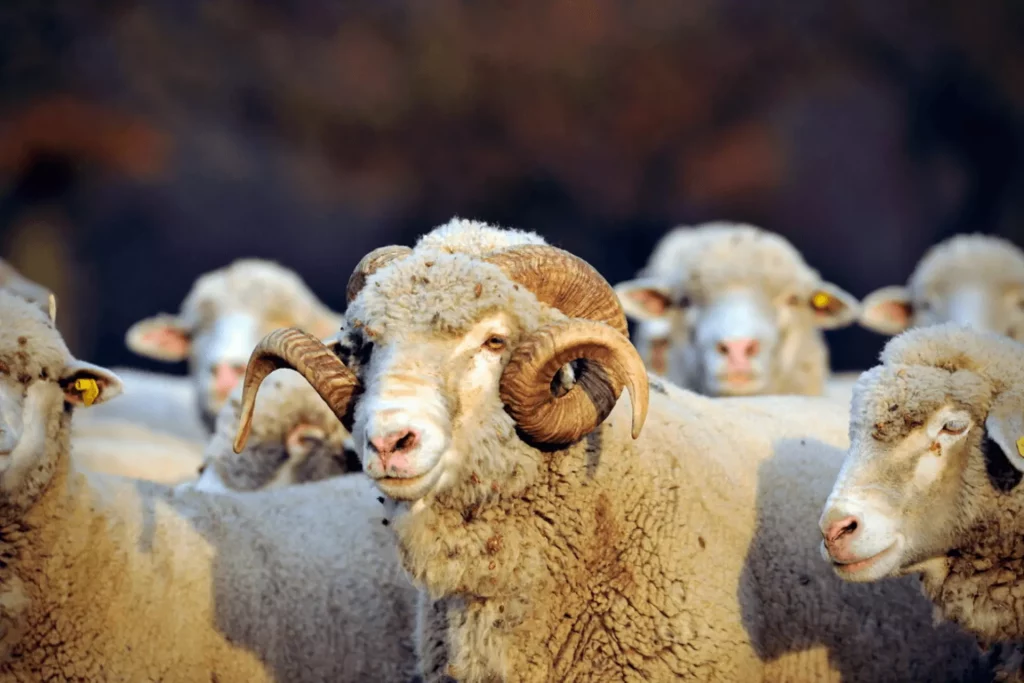Have you ever taken the time to study the differences between merino wool and other types of Wool before buying something? The majority of people are unaware that there is a significant difference, yet there is. Merino wool is derived from a unique breed of sheep with extremely fine hair, known as the merino.
Wool that has been treated in this manner is softer and more pleasant to wear than other types of Wool. Merino wool is also less itchy than other types of Wool, which makes it an excellent choice for sweaters and other apparel items. In terms of softness and comfort, merino wool is unquestionably the best material to choose.
Merino wool has various features, which we will examine in this article and contrast with the properties of other varieties of Wool. We’ll go over the advantages of using merino wool during the class and why it’s becoming a popular option among knitters and crocheters. Keep an eye out for additional information!
Table of Contents
What is Merino Wool?

According to the USDA, sheep’s wool is the most common and commonly accessible type of Wool on the market today. There are many different varieties of sheep wool available, depending on the breed of sheep used.
Melton, Shetland, loden, lambswool, and merino are the most common breeds. Merino wool is derived from Merino sheep, primarily found in hilly parts of Australia and New Zealand. Merino wool is a high-quality fiber that is quite durable.
Merino wool is finer in texture than regular Wool. This results in a more luxurious, more flexible, and less scratchy wool. Because of its natural flexibility and strength, this Wool is also a very durable fiber.
This Wool is rather lightweight compared to the amount of warmth it provides. Because of these excellent characteristics, merino wool is an excellent choice for outdoor activities like trekking.
In addition, it is crucial to highlight that, despite the widespread usage of the term “merino wool” in the textile business, the term does not necessarily relate to 100 percent Merino wool.
What is Regular Wool?

Wool is a fiber made from hairy animals such as goats and sheep. It is used to make clothing and other items.
For example, angora is a type of Wool derived from rabbits’ fur, but cashmere and mohair are Wool derived from goats’ hair.
Wool may be used in a variety of different ways. Wool is a good insulator, so we can use it to produce winter garments such as sweaters, jackets, socks, and hats because it keeps us warm.
Wool has natural air pockets, which help trap the heat generated by the body inside the garment and prevent it from escaping. This assists us in staying warm during the cold months.
Furthermore, we may utilize Wool to make various additional things, including blankets, rugs, saddle cloths, and carpets. It is also vital to mention that Wool is used to produce knitted garments.
Wool fiber is soft and absorbs moisture; it is also resilient and flexible, making it an excellent choice for clothing. Additionally, it does not wrinkle easily and returns to its original shape.
A variety of characteristics influence the quality of Wool, including yield, fiber diameter, crimp, color, and staple strength, to name a few examples.
What is the Distinction Between Wool and Merino Wool?
Sheep and goat wool are examples of textile fibers derived from the fur of hairy animals such as sheep and goats; merino wool, on the other hand, is a textile fiber derived particularly from Merino sheep.
As a result, the Wool may be derived from various hairy animals, including sheep, goats, and rabbits, whereas Merino wool is derived from the Merino sheep. For the most part, Merino wool is softer and finer in texture than regular Wool.
It’s also more flexible and less stretchable than ordinary Wool, making it a good choice for knits. This is the most significant distinction between Wool and Merino wool. While Wool is typically used for winter outerwear, Merino wool is particularly well suited for outdoor activities such as hiking.
Regular Wool Vs. Merino Wool: Main Differences

As you can see here, there’s a significant difference between normal Wool and merino wool. Please keep in mind that even high-end wool clothes might be made with yarn of equal grade. I’m just talking about generic wool clothing and accessories in the same price range as merino wool.
If you haven’t experienced merino wool clothes yet, you’re missing out on a great experience. If you don’t trust me, try a pair of Merino Wool Socks to see for yourself. They’re insanely comfy.
The Advantages of Merino Wool
There’s a good reason why wool apparel has been around for centuries: it’s warm and comfortable. Even now, nothing can compare to the warmth and comfort that Wool provides. Wool base layers are the best option for gear that will keep you safe in difficult situations.
Compared to typical Wool, merino wool has several distinct advantages. Antimicrobial and moisture-regulating qualities provide great insulation while remaining light, non-itching, non-smelling, and non-creasing in use.
Regular Wool has qualities comparable to synthetic Wool; however, it performs somewhat poorer in all areas. Base layers made of merino wool are just unbeatable.
1. Temperature Regulating:

What matters is that you can keep your merino wool clothing on no matter how hot or cold the weather gets outdoors. Wool provides warmth in the winter and keeps you cool in the summer. It’s the ideal choice for all-year-round comfort.
When it comes to regulating temperature, wool fibers have two primary mechanisms. The rippling texture of the weave traps air, which acts as a natural insulator. It operates in a similar way to how insulation works in your home’s walls.
Additionally, merino wool employs a cooling effect to keep you cool or warm. Wool can absorb up to 35 percent of its mass in moisture before it begins to feel damp or sticky.
As the moisture in the cloth begins to drain, the fabric becomes cooler when compared to the surrounding air. This system operates on the same concept as evaporative air conditioning systems, which are similar.
2. Exceptionally Soft:
Wool allergies are exceedingly unusual; thus, it is likely that you do not have an allergy to Wool. Your skin is just responding to the scratchy fibers found in low-cost wool clothing.
Itching should not be a problem when wearing merino wool clothing! As a result of the extremely small fibers’ thinness, they are below the threshold of human sensibility. Furthermore, because they are so delicate, they bend as soon as they come into touch with your skin.
Unfortunately, some people continue to experience small allergic responses to merino wool, despite the advances in technology. Loose threads are the most common source of this problem, and they will go away after several wash cycles.
3. Antimicrobial Characteristics:

You don’t want to be known as the “smelly guy” when hiking. On the other hand, Wool contains antibacterial characteristics, making it impossible for germs to attach to the fibers.
The benefit of this is that you may wear the same merino wool outfit for several days in succession. Walking in my merino wool socks for three to four days before they begin to smell is not uncommon for me.
4. Moisture Wicking:
Before it becomes wet to the touch, Wool can absorb up to 35 percent of its weight in water before becoming soggy to the touch. The fiber’s surface remains dry as moisture is drawn into the fiber core.
Wool retains its warmth even after being wet. Wool has such a wide range of applications because of this. It makes no difference what the weather is like! Wool clothes may be worn in any weather conditions, including rain, snow, and summer heat.
The porous nature of merino wool allows you to sweat and regulate your body temperature independently. You’ll be comfortable and cool in the summer and warm and cozy in the winter. If you haven’t experienced merino wool underwear yet, you’re missing out on something special.
5. Environmentally Friendly:

Wool, in contrast to other types of yarn, is ecologically friendly. All you need is a large open field and a herd of Merino Sheep to get started. The sheep are sheared twice a year (this causes no discomfort), and they spontaneously develop a fresh coat after each shortening.
Wool is also incredibly durable, which means you will produce less waste as a result. The abuse a wool sweater can survive on a fishing boat is proof that it can resist anything. Merino wool may survive for a decade or more if washed less frequently and made of exceptionally resilient fibers.
6. Easy to Care:
As a result of its odor-neutralizing characteristics, Wool is extremely easy to care for. Wool clothing still has to be washed now and again, but it can usually be left out for a few days without smelling.
After a short rinse and rub down with recyclable soap, you’re ready to hit the trail again. You may throw your wool clothing in the washing machine when you arrive home.
Most modern wool clothing may typically be washed on the “Normal Wash Cycle with warm water and standard detergent.” Wool is best dried by hanging to avoid damage, but it can be dried in the dryer if pre-shrunk.
Frequently Asked Questions:
Is Merino wool more or less warm than Wool?
Merino wool retains its warmth far better than normal Wool. In contrast to conventional Wool, which generates heat only when it is thick enough, merino wool generates heat on its own, thanks to the particular structure of its fibers, which makes it very warm.
Is Merino wool, as the name suggests, Wool?
Merino wool is significantly finer and softer than normal Wool, making it ideal for delicate garments. It is produced by Merino sheep, which graze in the highlands of New Zealand and Australia and provide a high yield of Wool.
Is merino wool scratchy to the touch?
They are non-irritating and non-itching, and they have a natural ability to repel smells and remove excess sweat. A bottom layer for wintertime warmth, underwear for at-home or vacation, or socks for everyday wear and hiking trails, merino feels silky and works in unison with your skin no matter what you’re wearing.
What is it about Merino wool that makes it so expensive?
Merino wool is expensive due to time, labor, and other expenses in its production and processing. When you combine it with growing demand and a limited supply of merino wool to meet that need, the reasons for the high price of merino wool become very obvious.
Is it possible to wear Merino wool in the summer?
While it may seem strange, merino wool is one of the most lovely fabrics to wear in the summer. Merino’s extraordinarily thin, lightweight fibers pull moisture away from your skin and dissipate it into the air, keeping you cool and comfortable even in the hottest of weather conditions.
Wrapping it Up
We may never determine which type of Wool is superior, but we know that Merino Wool and ordinary Wool have distinct benefits. With a wide range of alternatives accessible to you, the decision on whether or not you want the highest-quality product for your needs is entirely up to you.
Merino Wool is our top suggestion if you’re searching for a stylish and functional fabric with performance benefits like odor resistance and moisture-wicking capabilities. If, on the other hand, money is the most important consideration in your decision-making process, then go ahead and buy ordinary Wool!
While there are several valid reasons why people would choose one brand over another, it ultimately comes down to what is most important to them when choosing apparel items such as sweaters or socks.

![Regular Wool Vs. Merino Wool: Which One is Better? [2023] Wool vs. Merino Wool](https://cottoncashmereandwool.com/wp-content/uploads/2022/01/Wool-vs.-Merino-Wool-768x512.jpg)